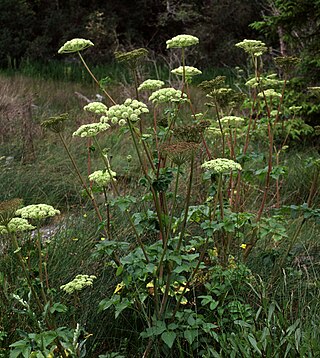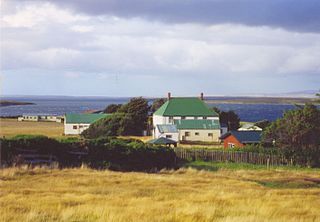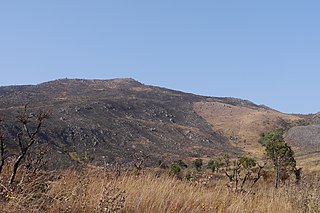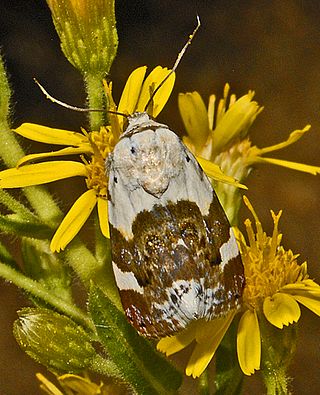
Ornamental grasses are grasses grown as ornamental plants. Ornamental grasses are popular in many colder hardiness zones for their resilience to cold temperatures and aesthetic value throughout fall and winter seasons.

Griselinia is a genus of seven species of shrubs and trees, with a highly disjunct distribution native to New Zealand and South America. It is a classic example of the Antarctic flora. It is the sole genus in the family Griseliniaceae. In the past it was often placed in Cornaceae but differs from that in many features.

Festuca (fescue) is a genus of flowering plants belonging to the grass family Poaceae. They are evergreen or herbaceous perennial tufted grasses with a height range of 10–200 cm (4–79 in) and a cosmopolitan distribution, occurring on every continent except Antarctica. The genus is closely related to ryegrass (Lolium), and recent evidence from phylogenetic studies using DNA sequencing of plant mitochondrial DNA shows that the genus lacks monophyly. As a result, plant taxonomists have moved several species, including the forage grasses tall fescue and meadow fescue, from the genus Festuca into the genus Lolium, or alternatively into the segregate genus Schedonorus.

Festuca ovina, sheep's fescue or sheep fescue, is a species of grass. It is sometimes confused with hard fescue.
British NVC community MG12 (Festuca arundinacea grassland) is one of the mesotrophic grassland communities in the British National Vegetation Classification system. It is one of three types of mesotrophic grassland classified as grass-dominated inundation communities.

Festuca pratensis, the meadow fescue, is a perennial species of grass, which is often used as an ornamental grass in gardens, and is also an important forage crop.

Salix lucida, the shining willow, Pacific willow, red willow, or whiplash willow, is a species of willow native to northern and western North America, occurring in wetland habitats. It is the largest willow found in British Columbia.

Festuca rubra is a species of grass known by the common name red fescue, creeping red fescue or the rush-leaf fescue. It is widespread across much of the Northern Hemisphere and can tolerate many habitats and climates. It is best adapted to well-drained soils in cool, temperate climates; it prefers shadier areas and is often planted for its shade tolerance. Wild animals browse it, but it has not been important for domestic forage due to low productivity and palatability. It is also an ornamental plant for gardens.

Angelica lucida is a species of angelica known by the common names seacoast angelica and sea-watch. It is also one of many species in the celery family which are casually called wild celery.

Festuca californica is a species of grass known by the common name California fescue.

Festuca idahoensis is a species of grass known by the common names Idaho fescue and blue bunchgrass. It is native to western North America, where it is widespread and common. It can be found in many ecosystems, from shady forests to open plains grasslands.

Tussock grasses or bunch grasses are a group of grass species in the family Poaceae. They usually grow as singular plants in clumps, tufts, hummocks, or bunches, rather than forming a sod or lawn, in meadows, grasslands, and prairies. As perennial plants, most species live more than one season. Tussock grasses are often found as forage in pastures and ornamental grasses in gardens.

The Angolan montane forest-grassland mosaic ecoregion is located on the east-facing inland side of the belt of mountains that stands parallel to the coast of Angola, 50–100 km inland.

Acontia lucida, the pale shoulder, is a moth of the family Noctuidae. The species was first described by Johann Siegfried Hufnagel in 1766.

Blatačko Lake is a natural lake 21 kilometers to the north-east of Konjic, in Konjic municipality, Bosnia and Herzegovina. The lake is a central feature of the natural & cultural-historical ensemble - cultural landscape - designated as National Monument of Bosnia and Herzegovina.

Festuca gigantea, or giant fescue, is a plant species in the grass family, Poaceae. Because this and other members of Festuca subgenus Schedonorus have more in common morphologically with members of the genus Lolium than with Festuca and often produce fertile hybrids with other Lolium species, Festuca gigantea has been recently published as Lolium giganteum(L.) Darbysh. (1993) and then as Schedonorus giganteus(L.) Holub (1998). Sources vary as to which placement is more acceptable.
Poeciliopsis lucida, the clearfin livebearer, is a species of small freshwater fish in the family Poeciliidae. Reproduction is viviparous, and the female can have several clutches of young developing internally at the same time. It is one of several species of small livebearing fish endemic to Mexico that were described in 1960 by the American ichthyologist Robert Rush Miller.
Festuca baffinensis also called the Baffin Island fescue is a species of grass in the Poaceae family. The name was published in Bulletin of the National Museum of Canada in 1940. The specific name 'baffinensis' was named after Baffin Island in canada. This species is native Subarctic Northern Hemisphere to W. Central U.S.A. It was first described in 1940 by Polunin.














